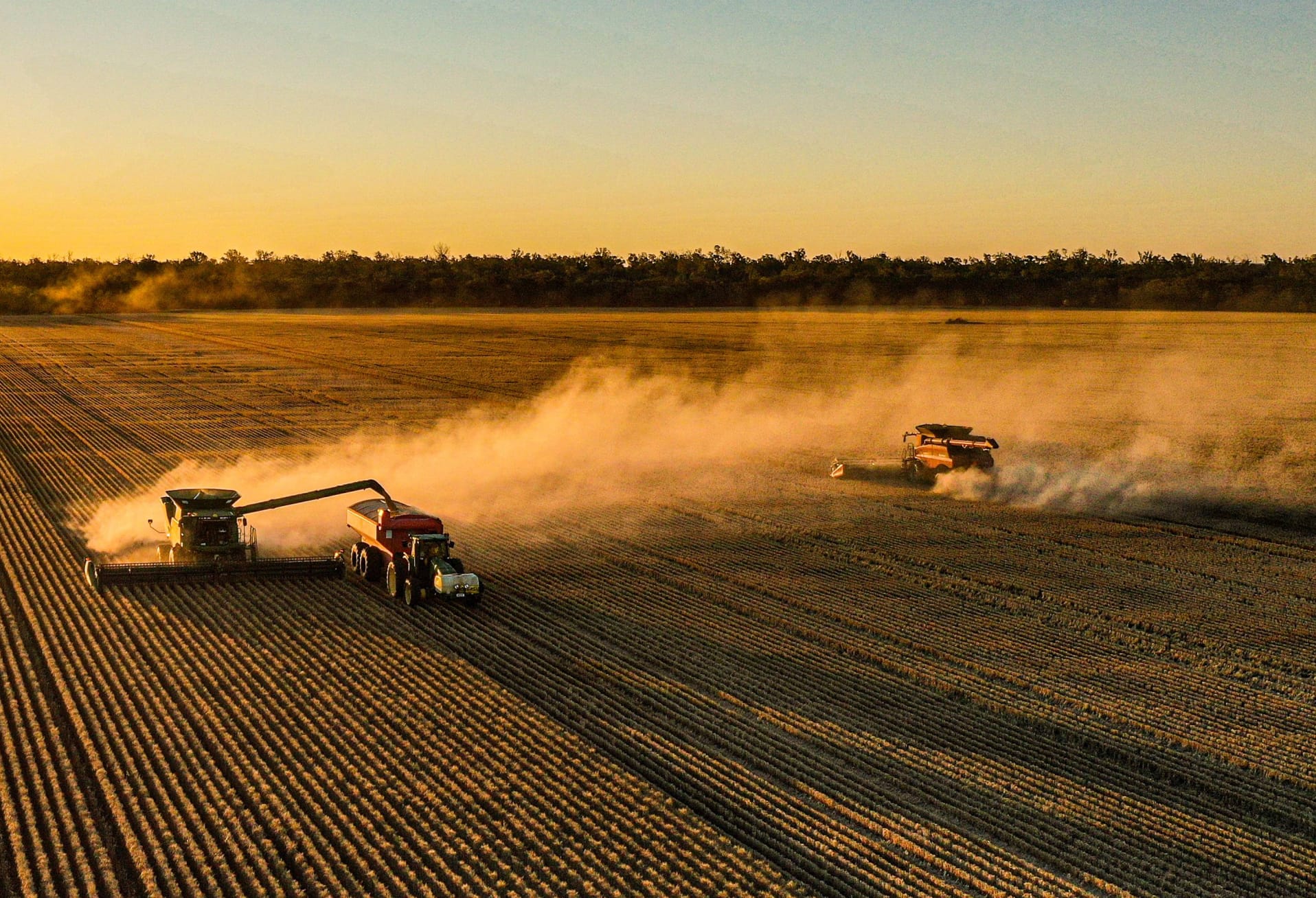Take home messages
- Compass, Commander, Scope CL and Fathom were the varieties most affected by lodging when harvest was delayed in a very high yielding environment.
- Spartacus CL and Oxford had better head retention than Fathom and Westminster which were the poorest.
- Delaying harvest by three and a half weeks incurred a 2t/ha yield loss. In an 8t/ha crop this equates to one per cent of yield per day lost on average (based on 2016 data).
Background
While it is common for growers to act quickly when there is a threat of a disease that may result in 10- 15 per cent yield loss, arguably, not enough emphasis is put on the losses that can occur at harvest.
A major issue this year was secondary tillers forming close to maturity resulting in harvest being delayed as growers waited for these tillers to ripen. A combination of this, and very poor barley prices, meant that in many instances wheat and pulse crops were harvested before barley, delaying it anywhere from two to four weeks after optimal timing.
This year, above average rainfall and good starting soil nitrogen levels, resulted in tall, bulky crops and consequently these heavy crops lodged prior to harvest, in particular Compass. The question was posed: “Will this earlier lodging (around grain fill) impact on further lodging and yield losses in susceptible varieties come harvest?”
It is important to understand that there are two types of lodging that can occur:
- Stem lodging, which is when the lower internodes begin to buckle, consequently causing the plant to fall over mainly due to poorer straw strength; and
- Stem brackling, which is when the plant stems break higher up causing the heads to be angled towards the ground.
Varieties also differ in their susceptibility to head loss. Severity can increase in lodged crops, when there is high nutrition or in crops that have greater disease pressure, all of which effect straw strength.
Being able to identify varieties that are most at risk in the event of a delayed harvest can help growers put into place appropriate management plans.
Aim
To compare the yield and grain quality of barley varieties when harvest is delayed.
Paddock details
| Location: | Kalkee |
| Annual rainfall: | 462mm |
| GSR (Apr-Oct): | 374mm |
| Soil type: | Clay |
| Paddock history: | 2015 lentils |
Trial details
| Crop type: | Commander, Compass, Fathom, Hindmarsh, Spartacus CL, La Trobe, Oxford, Scope CL, Urambie, Westminster, Rosalind and GrangeR barley |
| Treatments: | Harvested at the optimum time and delayed harvest |
| Target plant density: | 140 plants/m² |
| Seeding equipment: | Knife points, press wheels, 30cm row spacing |
| Sowing date: | 19 May |
| Replicates: | Four |
| Harvest date: | Optimum harvest: 8 December 2016
Delayed harvest: 3 January 2017 |
| Trial average yield: | Optimum harvest: 8t/ha
Delayed harvest: 6t/ha |
Trial inputs
| Fertiliser: | Granulock Supreme Z + Impact @ 50kg/ha at sowing plus @ 50kg/ha of urea at early tillering, mid tillering and late tillering |
Pests, weeds and diseases were controlled according to best management practice.
Method
A field trial was established comparing 12 barley varieties (sub-plots) harvested at two timings (main plots) in a split plot design trial. Harvest times were ‘optimum harvest’ (when crop had just reached physical maturity) and ‘delayed harvest’ (26 days after the optimal timing and after 50mm of rainfall).
Head loss counts were performed on all plots using a 50cm quadrat to determine a basis of head loss prior to the initial harvest. The same process was undertaken after the plots were harvested to measure the quantity of heads lost during the harvest process, as well as just prior to the second harvest timing. Measures of plant height were undertaken (base of stem to base of head) prior to the first harvest and lodging scores were visually assessed (when lodging started to occur and prior to both harvest timings). The number of grains per head was measured and 1000 grain weights for each variety were performed so head loss could be calculated as yield loss (t/ha).
Yield and grain quality (test weight, protein, retention, screenings) were also measured.
Table 1. Barley variety head loss rating, lodging rating, straw strength rating, height rating and actual plant height measurements.
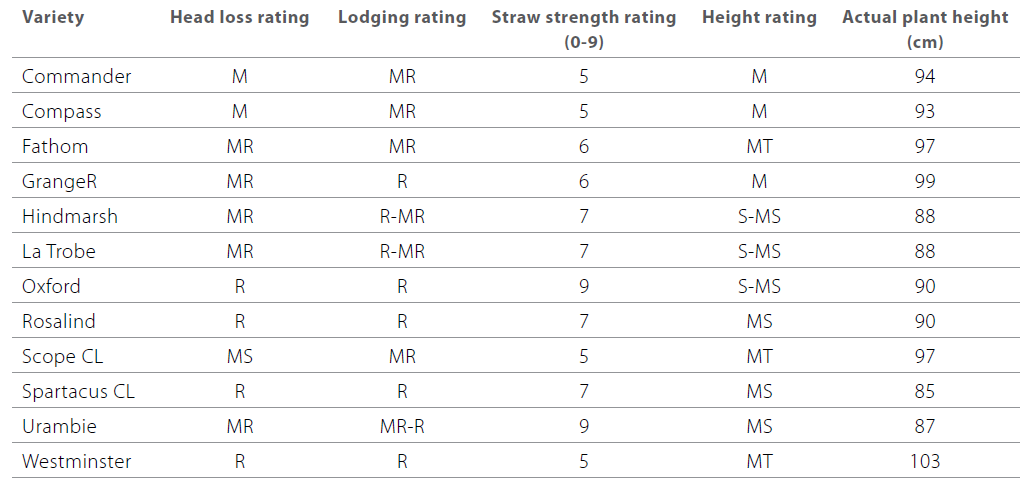
Head loss and lodging rating: R = resistant, MR = moderately resistant, MS = moderately susceptible, S = susceptible.
Straw strength: 1 = Very weak, 2 = weak-very weak, 3 = weak, 4 = weak-moderate, 5 = moderate, 6 = moderate-strong, 7 = strong, 8 = strong-very strong, 9 = very strong.
Height rating: T = tall, MT = moderately tall, M = medium, MS = moderately short, S = short.
These ratings for varieties may be dependent on the season.
Results and interpretation
Over the 26 days between optimum and delayed harvest, the trial site had 50mm of rainfall in separate events and four days prior to the first harvest timing, there was 2.6mm of rain.
Six days before the second harvest, the site received 35mm of rainfall (over two days) and maximum wind speeds up to 67km/hr. This would have contributed to the high amounts of head loss in nearly all varieties.
The trial in 2016 was more exposed to wind than the 2015 delayed harvest trial located at Wemen (northern Mallee), possibly accounting for the increased head loss amongst varieties (Figure 1). The Wemen trial received 76mm of rainfall and irrigation (combined) during the harvest period while at the 2016 Kalkee trial received 50mm of rain between the two harvest timings.

Figure 1. Maximum wind speed (km/hr) at Wemen in 2015 (delayed harvest in barley trial), recorded over 37 days between harvest timings, and wind at the 2016 Kalkee site over the 26 days between harvest timings.
What was the penalty when harvest was delayed?
In a high yielding environment, when barley harvest (mean of all varieties) was delayed by 26 days, there was a yield penalty of 2t/ha (Table 2). Head loss was higher when harvest was delayed. This was a consequence of wet and windy conditions causing greater lodging and deterioration of barley straw strength. A loss of 70 heads/m2 equates to approximately 1t/ha of yield loss (variety dependant).
As expected, rainfall during the period between harvest timings, resulted in the grain swelling
(retention increased) and becoming lighter in weight (test weight decreased) – a consequence of rewetting of the grain. Retention was still within malt thresholds in both harvest timings, whereas test weight fell below malt specifications when delayed (mean of all varieties). Protein and screenings didn’t significantly change when comparing the two harvest timings.
Table 2. Head loss, grain yield, protein, test weight, retention and screenings compared for each harvest timing.

Was there a difference between varieties?
All varieties lost yield when harvest was delayed, with some varieties being significantly worse than others. The greatest penalty was seen in Westminster (reduced by 3.3t/ha) and GrangeR (reduced by 2.9t/ha) when harvest was delayed by 26 days. All other varieties lost between 1.3-2.5t/ha (Figure 2).
Urambie, Oxford and Rosalind yielded the highest when harvested on time. With a delayed harvest, Urambie still yielded significantly higher than Compass and Commander when harvested on time.
Both Urambie and Oxford are later maturing varieties, making them suited to a wetter season, however these varieties have not performed well in ‘typical’ Wimmera and Mallee seasons. Rosalind, on the other hand, showed it can perform well in higher yielding years and previous drier seasons, increasing the attractiveness of this variety.
The varieties that incurred the least yield penalty when harvest was delayed were Spartacus CL and Oxford.

Figure 2. Grain yield (t/ha) for all varieties at optimum harvest and delayed harvest.
Stats: Variety P<0.001, LSD=0.30t/ha; Harvest timing P<0.001, LSD=0.15t/ha; Variety x harvest timing P<0.001, LSD=0.45t/ha; Overall CV=5%.
Grain quality
Retention among varieties didn’t differ between harvest timings, except for Urambie. Retention increased by 10 per cent when Urambie was delayed (Table 3).
Protein in Oxford and GrangeR increased when harvest was delayed. All other varieties were similar in protein when harvested at the optimum time or delayed harvest. The increase in protein is hard to explain as generally when grain size increases it creates a protein dilution effect.
There was a trend for test weight to decrease in varieties when harvest was delayed, but no variety was different to another. There were no differences in screenings when harvest was delayed.
Based on all quality parameters, when harvesting in the optimum window, all malt varieties achieved malt grade. When harvest was delayed, Commander, La Trobe, Scope CL and Compass and Spartacus CL (both undergoing accreditation) did not reach the malt threshold based on low test weight.
This season many grain growers had barley downgraded to feed due to dark tipping or ‘bin burn’, which is grain that has been discoloured due to weather conditions during the season. In this trial, there was only minor levels of dark tipping evident and it didn’t appear to be variety specific.
Table 3. Grain quality protein (%), test weight (kg/hl) and retention (%) when barley was harvested at optimum and delayed times.
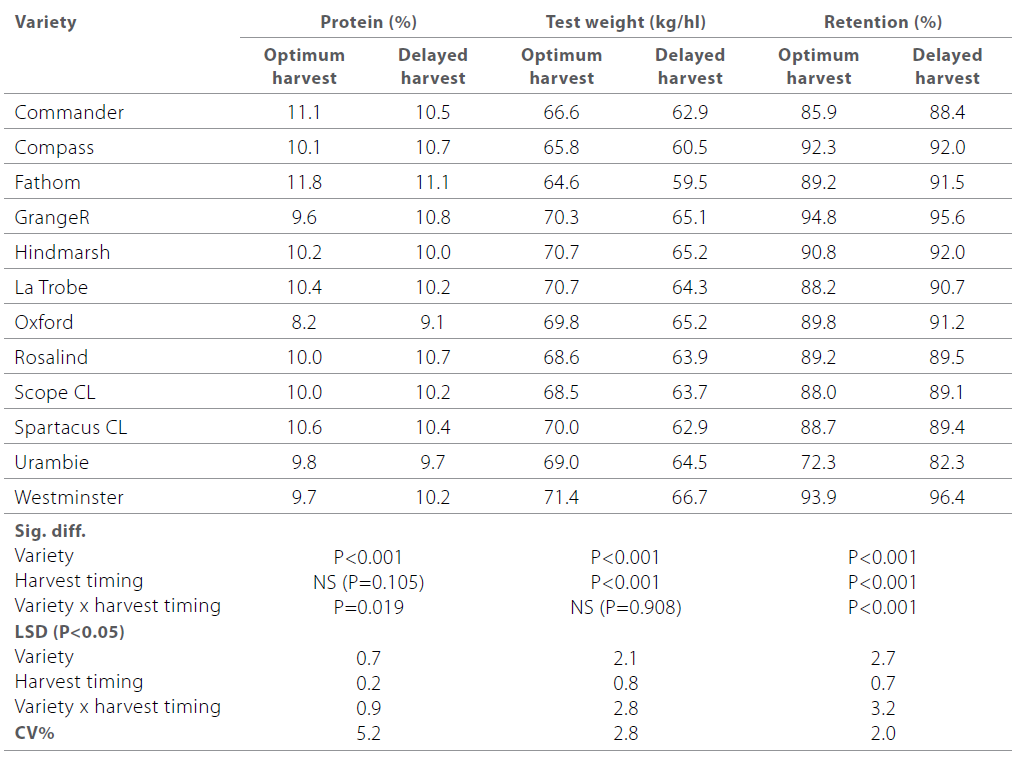
What contributed to yield loss when harvest was delayed?
Lodging
Heavy, bulky crops earlier in the season saw some varieties falling over during the grain filling period due to continuous weekly rainfall events over this time. Susceptible varieties stood up and fell back over multiple times, before remaining lodged to some degree. This was the case in particular for Compass. However, the impact of this earlier lodging did not appear to impact on yield. If there was an impact, this would be reflected in grain quality parameters, such as higher screenings and lower retention (because of smaller grains forming, due to lodging restricting nutrient flow).
The varieties that were most affected by lodging were Compass and Commander at both harvest timings (Figure 3). Most other varieties had minor to no lodging prior to the first harvest. By the second harvest timing, due to strong winds and rainfall, Fathom, which generally has good standability had 50 per cent lodging and Scope CL was also affected to the same extent (Figure 2). Scope CL, however, was most affected by brackling, which can cause more head loss because the heads end up being tilted to the ground. This causes losses at harvest because heads are below the cutter bar or snap off when they come into contact with the bar. Anecdotally, the use of crop lifters has been found to reduce losses
under these situations.
The longer harvest is delayed, the weaker the straw or stem becomes. Some varieties will inherently brackle or lodge, such as Compass and Scope CL, even in an average year.
Shorter varieties are in general more resistant to lodging than taller varieties. Compass, Commander and Scope CL, while not the tallest of varieties, have a weaker straw strength, making them more prone to lodging and yield loss when harvest is delayed relative to shorter varieties such as Spartacus CL or Hindmarsh. Varieties which lodged in the trial (Figure 2) are in line with lodging ratings (Table 1).

Figure 3. Lodging (%) for individual varieties just prior to the optimum harvest and delayed harvest (Stats: Variety x harvest timing P<0.001, LSD=15.3%, CV=53.1%).
Head loss
Head loss was quite severe in nearly all varieties when harvest was delayed (Figure 4). This was a consequence of rainfall and high maximum wind speeds over this period (Figure 1).
Varieties which generally have good head retention such as Commander, Westminster, GrangeR and Fathom still suffered when harvest was delayed (Figure 4). On the day of the delayed harvest timing, it was observed that plots of Fathom had brittle heads that were easily snapping off. Some of the varieties that exhibited high head loss didn’t necessarily suffer higher yield loss, in particular Fathom (possibly having more heads to start with).
Head loss in Compass was evident before the first harvest (average loss of 16 heads/m2) possibly due to it being ripe very early and having poor straw strength (Figure 3). Some of the other varieties suffered minor head loss. Interestingly, even though head loss by the second harvest was high in Compass, it wasn’t as pronounced as in other varieties.
The interaction between plant height and head loss was analysed, revealing the taller the variety (based on plant height) the greater the head loss incurred (P=0.004, LSD=38.5, CV=44%). La Trobe which is a short to moderately short variety however, had particularly high head loss so didn’t follow this trend. The higher head loss in taller varieties is not unexpected, with the plant more susceptible to movement in windy conditions that cause heads to come into contact with one another.
Shattering
Shattering was another factor that contributed to yield losses in this trial. Westminster and GrangeR appeared to be most affected and it is likely that shattering contributed to the large yield reduction when harvest was delayed in these varieties.
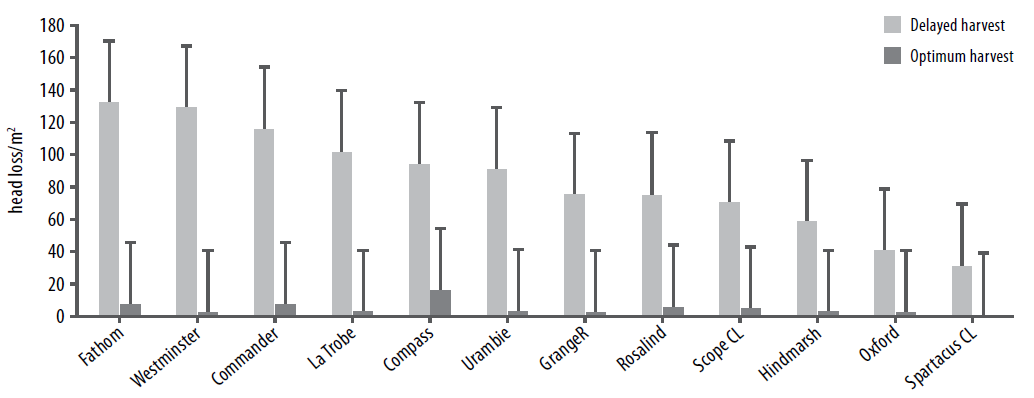
Figure 4. Percentage of yield loss when delaying harvest and the amount of head loss/m2 when harvest is delayed. Stats: Variety x harvest timing P=0.01, LSD=38.32, CV=59.3%.
How did 2016 compare with other years?
Figure 5 shows the percentage of yield loss for 2013-2016 when harvest is delayed and the average yield loss for varieties over the four years (note: Westminster and Spartacus CL mean is from two years only). It indicates, that years with a higher yield potential, are also at risk of higher yield loss. This can be seen in 2013 (Watchupga East) and 2016 (Kalkee) which were average to above average years compared with 2014 (Horsham) and 2015 (Wemen under irrigation) which had a dry finish to the season.
On average, over multiple seasons, most varieties incur an 8-15 per cent yield loss when harvest is delayed (except Westminster 25%).

Figure 5. Per cent (%) yield loss for nine varieties from 2013-2016 when harvest is delayed. Note: Westminster and Spartacus CL only have two years of data.
Commercial practice
The 2016 season is one most growers will remember for the excellent crops grown. However, there were many challenges, in particular secondary tillers forming later in the season and poor barley grain prices. A combination of both, meant barley crops were harvested later than the ideal time – to allow secondary tillers to ripen and prioritise more profitable crops at risk (pulses, wheat).
Despite these events, the greatest frustration or annoyance observed, was the yield loss seen in barley when harvest was delayed.
The results of this trial show that as a crop, barley is particularly susceptible to yield loss if harvest is delayed. In this trial the average yield loss from delayed harvest was 2t/ha (mean of all varieties). When harvest was delayed by 26 days, this equates to roughly one per cent yield loss a day from the optimum harvest date in 2016. This is significantly higher than has been shown in previous research.
Under a high yielding environment all varieties showed susceptibilities to delayed harvest, losses were caused by lodging, shattering of the grain and head loss.
Table 4 can be used as a guide to determine the risk factor of a variety (based on lodging and head loss that contribute to yield loss) if presented with a season similar to this year. Scope CL, Fathom, Compass and Commander have a high risk rating (if harvest is delayed), and need to be prioritised ahead of other barley varieties. Oxford, Spartacus CL and Hindmarsh have a low risk rating indicating that they are less susceptible to yield losses when harvest is delayed.
These results will vary in different seasons. Previous research has shown in an average year, Fathom and Commander have good standability and head retention.
Table 4. Lodging and head loss ratings for the 2016 year relative to other varieties in the trial and a risk rating if harvest is delayed.
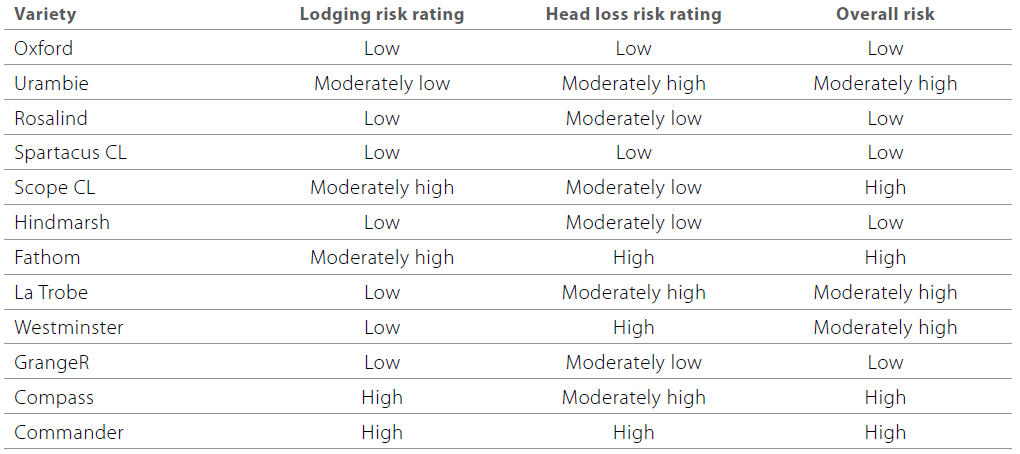
Yield should still be the primary driver of variety selection in barley rather than its tolerance to yield loss when harvest is delayed. Spartacus CL, Rosalind, Fathom, Hindmarsh, La Trobe and Compass are all consistent performing varieties in the Wimmera and Mallee (refer to ‘Barley varieties and time of sowing’, page 70 and ‘Barley variety performance in 2015’, BCG 2015 Season Research Results, page 69). Scope CL, Compass and Fathom, which had achieved average yields in trials from 2013 to 2016, have shown varying degrees of susceptibility to delayed harvest either through head loss, lodging or a combination of both. These varieties should be prioritised at harvest in any given year.
If we are presented with a similar season, and more attractive grain prices (and malt premiums), then variety selection would be more important to achieving better financial returns.
Other valued options that could be considered to minimise risk and yield loss are:
- Windrowing crops – this year it could have been beneficial due to secondary tillers forming later
in season - Using crop lifters – reduce further yield losses in badly lodged crops
- Plant growth regulators (PGRs) – can reduce plant height and increases straw strength potentially reducing lodging and head loss (refer to PGR use in barley, page 29)
- Grazing – reduces plant height and consequently lodging with no yield penalty (refer ‘Cereal
variety and nitrogen responses to grazing’, page 196).
On-farm profitability
In 2016, delaying harvest caused an average yield reduction of 2t/ha resulting in a loss of $279t/ha in gross income (based on a feed price of $139.50 at Dooen, 1 December 2016). Grain quality was also reduced to feed.
The significant decrease in yield between varieties when harvest was delayed resulted in large losses in gross income (Table 5). Westminster lost $463t/ha compared with Spartacus CL which suffered a $178t/ha loss in gross income when harvest is delayed.
Table 5. Yield loss (t/ha) when harvest is delayed and consequential gross income loss based on grade achieved.
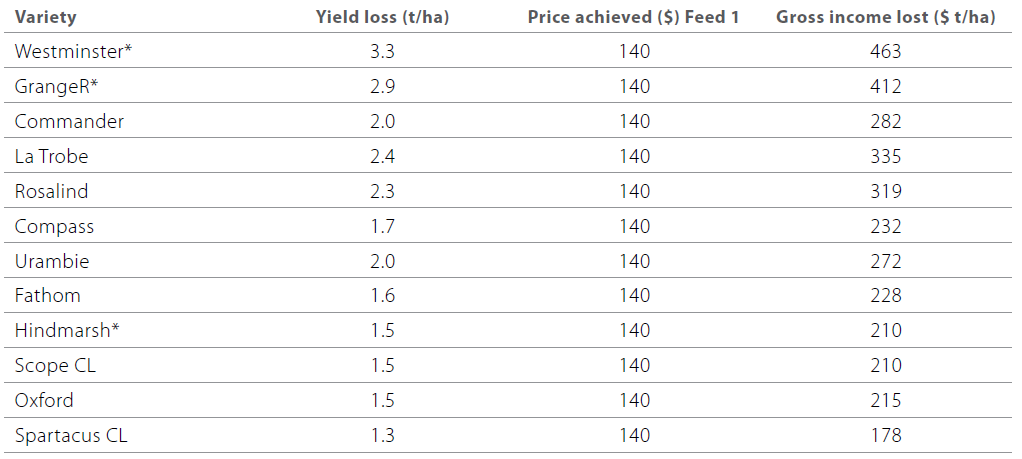
*Note: There is no segregations for Westminster, GrangeR and Hindmarsh (which made malt/food grade) at Dooen grain receival, a Feed 1 price has been used.
References
Murray J., 2014, 2014 BCG Season Research Results, ‘Impact of delaying harvest in barley’ pp. 78-81.
GRDC Victorian Winter Crop Summary 2016.
Acknowledgements
This research was funded by the GRDC Barley Agronomy for the Southern region project (DAN00173).
